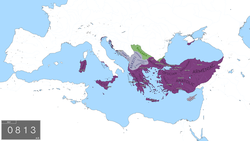
Back Βυζαντινή Αυτοκρατορία υπό τη Δυναστεία του Νικηφόρου Greek Imperio bizantino bajo la dinastía de Nicéforo Spanish Impero bizantino durante la dinastia niceforiana Italian 니케포로스 왕조 치하의 동로마 제국 Korean نیکیفوروسی شاہی سلسلہ کے تحت بازنطینی سلطنت Urdu
Byzantine Empire
| |||||||||
|---|---|---|---|---|---|---|---|---|---|
| 802–813 | |||||||||
 The Byzantine Empire in 813, after the abdication of Michael I | |||||||||
| Capital | Constantinople | ||||||||
| Common languages | Greek | ||||||||
| Government | Bureaucratic semi-elective monarchy | ||||||||
| Emperor | |||||||||
• 802–811 | Nikephoros I | ||||||||
• 811 | Staurakios | ||||||||
• 811–813 | Michael I Rangabe | ||||||||
| History | |||||||||
• Accession of Nikephoros I | 802 | ||||||||
• Abdication of Michael I | 813 | ||||||||
| |||||||||
| Nikephorian dynasty | ||||||||||
|---|---|---|---|---|---|---|---|---|---|---|
| Chronology | ||||||||||
|
||||||||||
| Succession | ||||||||||
|
||||||||||
The Byzantine Empire under the Nikephorian dynasty began following the deposition of the Byzantine empress Irene of Athens, the throne of the Byzantine Empire passed to a relatively short-lived dynasty, the Nikephorian dynasty, named after its founder, Nikephoros I. The empire was in a weaker and more precarious position than it had been for a long time and its finances were problematic.[1]
During this era Byzantium was almost continually at war on two frontiers which drained its resources, and like many of his predecessors, Nikephoros (802–811) himself died while campaigning against the Bulgars to the north. Furthermore, Byzantium's influence continued to wane in the west with the crowning of Charlemagne (800–814) as Holy Roman emperor by Pope Leo III at Old St. Peter's Basilica in Rome in the year 800 and the establishment of a new empire in Western Europe laying claim to the universal Roman monarchy.
- ^ Jenkins. Byzantium The Imperial Centuries AD 610-1071. p. 117
© MMXXIII Rich X Search. We shall prevail. All rights reserved. Rich X Search